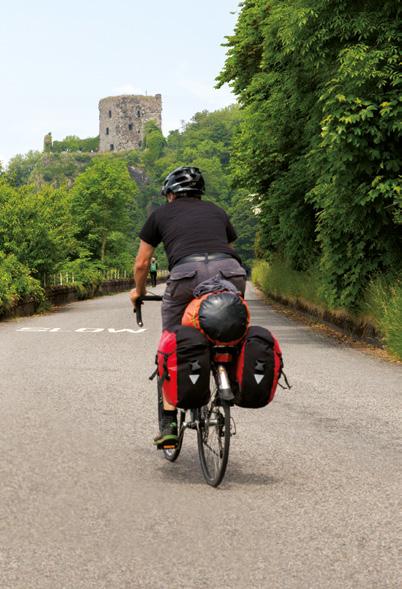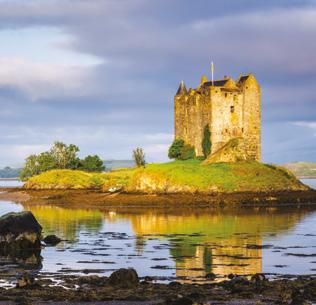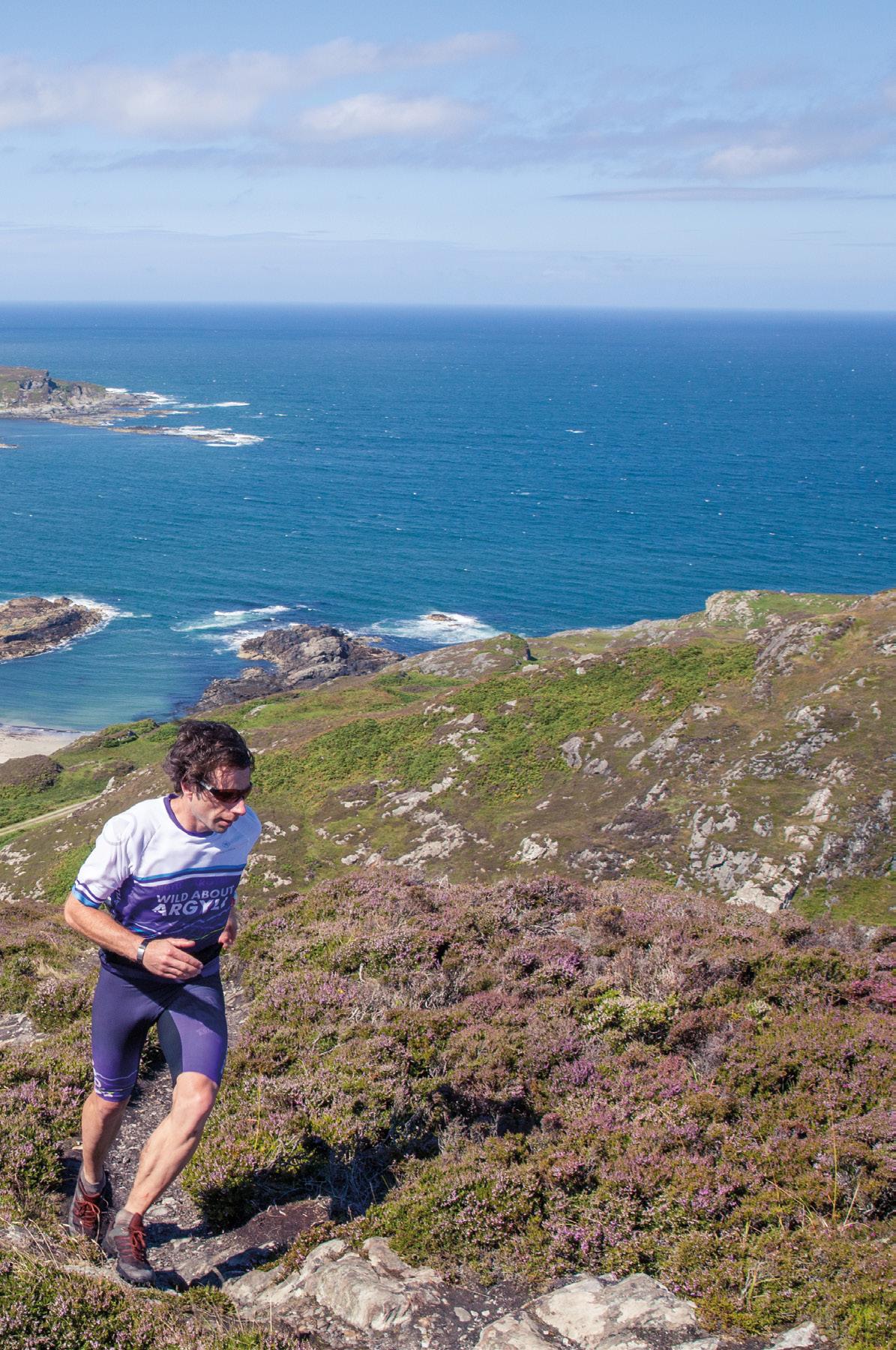
12 minute read
Long Distance Trails
If you love getting outdoors and up close and personal with nature, then long distance walking, cycling or kayaking is the best way to explore and scour Scotland’s adventure coast.
LONG DISTANCE WALKING
Advertisement
Get your boots looked out, weather-proof gear packed and suncream at the ready. When walking you need to be prepared for all weathers, no matter the season, so plan ahead and bring it all. If you’re in luck you might get all four seasons in one day!
The Loch Lomond & Cowal Way
Established at the turn of the century and 91km (57 miles) long, this route stretches from Argyll’s Secret Coast to the bonnie banks of Loch Lomond. The Cowal peninsula is rich in wildlife and scenery, typified by the stunning seascapes of the Kyles of Bute, and the spectacular mountains of the “Arrochar Alps’. Add to these, the clan histories and ruined castles of the Lamonts, the Campbells and the MacLachlans together with the numerous standing stones, burial cairns and rock carvings from the Stone Age and Bronze Age eras, and Cowal becomes a visitor’s paradise. Plan your walk at
www.lochlomondandcowalway.org
The Kintyre Way
Stretching from Tarbert at the north end of Kintyre, to Dunaverty Bay in the south, the Kintyre Way criss-crosses the peninsula and is easy to navigate with markers along the way. This 140km (87 miles) long trail connects communities, landscape, people and produce. With hidden coves, deserted beaches, tiny fishing communities, gentle hills and tasty local produce, you will always experience a warm friendly welcome. Plan your 4-7 days worth of serious hiking and gentle rambling at
www.thekintyreway.com
The Three Lochs Way
The long distance walking gateway to Argyll and the Isles, linking Loch Lomond, the Gareloch and Loch Long via Balloch, Helensburgh, Garelochhead, Arrochar and Inveruglas. Highlights include Rennie MacIntosh’s Hill House, the glorious gardens of Helensburgh, atmospheric Glen Fruin and tremendous views of the Arrochar Alps. Rarely rising above 250 metres, the 55km (34 miles) walk offers plenty of options for shorter day walks or a fully linked trail. Plan your way at
www.threelochsway.co.uk
The West Highland Way
This 154km (96 miles) route starts at Milngavie passing through Mugdock Country Park, then follows the shores of Loch Lomond, passing Ben Lomond, through Glen Falloch and Strathfillan, dipping into Argyll before crossing Rannoch Moor, past Buachaille Etive Mor to the head of Glencoe. It then climbs the Devil’s Staircase, descending to sea level to cross the River Leven at the head of Loch Leven before entering Lairigmor and Glen Nevis, and finishes at Gordon Square in Fort William. Join the popular trail and company of fellow walkers by planning at www.west-highland-way.co.uk
The West Island Way
Running the full length of the Isle of Bute for approximately 40km (25 miles), the West Island Way embraces a variety of landscapes; seashore, moorland, farmland and forest. The natural history, geography, geology and ancient history of the island are revealed at every turn. Plan your way at www.visitbute.com
The John Muir Way
A new trail addition in 2014, and at 214km (134 miles) this coast to coast route runs across central Scotland between Helensburgh in Argyll in the west and Dunbar in the east, passing through the very best scenery the central belt has to offer. Designed to be easily accessible to a wide range of users and close to local communities and transport links, find your way at
www.johnmuirway.org LONG DISTANCE CYCLING NETWORK Campbeltown to Fort William – the Caledonia Way
National route 78 of the National Cycle Network – known as the Caledonia Way - runs from Campbeltown to Inverness via Oban, Fort William and Fort Augustus.
Dunoon to Portavadie/Tarbert
National route 75 of the National Cycle Network connects Leith with Portavadie and Tarbert via Edinburgh, Glasgow and the ferries between Gourock and Dunoon.
Helensburgh and Lomond Cycleways
The Helensburgh and Lomond cycleways are part of the National Cycle Route 7, which runs from Sunderland to Inverness, via Penrith, Carlisle, Dumfries, Ayr, Glasgow, Pitlochry and Aviemore.
Balloch to Tarbet – West Loch Lomond Cycle Path
This 17 mile cycleway and footpath takes you from Balloch at the southern tip of Loch Lomond to Tarbet. The path is traffic free for most of the way, with only 2 short stretches on minor roads. It is suitable for cyclists, walkers, wheelchair users and horse riders.
www.sustrans.org.uk
THE ARGYLL SEA KAYAK TRAIL
With over 3700 kilometres of coastline, Argyll and the Isles claims some of the UK’s most beautiful and naturally diverse seascapes. The 153km (95 miles) sea kayak trail has nine access points linking Helensburgh in the east, through to Oban in the north offering some of the best coastal kayaking in Scotland.
www.paddleargyll.org.uk
Access Points
• Ganavan • Arduaine • Crinan • Ardishaig • Tarbert • North Bute • Toward • Dunoon • Helensburgh

Argyll Sea Kayak Trail at Ardishaig.
Cycling, Dunollie Castle, Oban.
The Caledonia Way, Cycle Touring Routes (Image credit John Linton).

EXPLORE ARGYLL’S MOST DRAMATIC LANDSCAPES ALONG THE CALEDONIA WAY Feature by Sustrans
Some of Argyll’s best known cycle touring routes and day trips are being promoted through a new online journey planner hosted by VisitScotland, as part of a nationwide campaign to get people to explore Scotland by bike. Created in partnership with Sustrans Scotland, the planner aims at encouraging visitors to Argyll and Bute through cycling day trips or longer challenges, such as the iconic Caledonia Way.
Running between Campbeltown and Inverness, the Caledonia Way is a ‘coast to coast’ cycling adventure, through spectacular highland landscapes rich in culture and history. Heavily influenced by Scotland’s iconic geography, the route follows both the Kintyre Peninsula and the Great Glen. It passes under the shadow of Ben Nevis and traverses Loch Ness, providing unrivalled views of famous castles and west-coast islands.
In Argyll, the route passes some of Scotland’s most iconic landmarks such as the Neolithic stone circles in Kilmartin Glen, the ancient ‘Coffin Road’ through Glen Lonan, and the instantly recognisable silhouette of Castle Stalker.
From the challenging moorland hills of the Kintyre Peninsula, to lengthy sections of family friendly traffic-free path along the historic Crinan Canal, the Caledonia Way offers something for every type of cyclist! And, despite some of the spectacular remote rural cycling on offer, this route is very accessible, making it simple for riders to complete shorter sections if required. “With cycle tourism estimated to be worth up to £345million to the Scottish Economy (Sustrans Scotland (2017) Leisure Cycle Tourism Guide), the move is part of a campaign to encourage Scots to discover more of what’s on their doorstep as the country emerges from lockdown.”
Sustrans’ new, targeted approach to promotion of cycle touring will give more of Scotland’s businesses and communities the opportunity to capitalise on the rapid growth of green and sustainable tourism, whilst encouraging visitors to enjoy some of Scotland’s most dramatic landscapes, in a responsible and sustainable way.
www.visitscotland.com/cyclingroutes
Sponsored by
CASTLES & MONUMENTS
Track time and history by visiting the wealth of prehistoric monuments and medieval forts and castles located throughout Argyll and the Isles. Learn about our predecessors and adversaries – and how our built heritage shaped the west coast and our connections with the rest of the world. The richest of history to be enjoyed today.
Argyll and the Isles is unbelievably rich in prehistoric sites with Kilmartin Glen in the heart of Argyll having one of the densest concentrations in the UK with over 800 sites within 6 miles! Also, many of these prehistoric sites across Argyll & the Isles have no visible remains above ground with some having been excavated and others still to be. Here are just some of the more important ones that you can visit.
Please note listed sites are protected by law, please respect these treasured places when you visit by adhering to any signs you see and follow the Scottish Outdoor Access Code.
OUR PREHISTORIC SITES TO VISIT
• Shell Middens, Mesolithic rubbish heaps perhaps 9,000 years old, Isle of Oronsay • Glecknabae, Mesolithic shell midden and
Neolithic chambered cairn, Isle of Bute • Brackley, Neolithic chambered cairn, Kintyre • Beacharra Neolithic chambered cairn, Kintyre • Lochbuie, Neolithic/Bronze Age stone circle, Mull • Cultoon, Bronze Age, standing stones circle, Islay • Strontoiller, Neolithic/Bronze Age standing stone/cairns, Lorn • Dunagoil, Late Bronze Age/Iron Age Vitrified
Fort, Isle of Bute • Kildonan, Iron Age Dun, Kintyre • Tirefour, Iron Age Broch, Isle of Lismore • Druim an Dun, Iron Age and Early
Historic Dun, Knapdale • Dun Eibhinn, Iron Age Dun, Isle of Colonsay • Dun Nosebridge, Iron Age Fort, Isle of Islay • Dun Mor Vaul, Iron Age Broch, Isle of Tiree • Castle Dounie, Iron Age Dun, Knapdale • Kilmartin Glen - Neolithic-Bronze Age cairns/standing stones - Nether Largie South chambered cairn - Templewood stone circles - Kilmartin Glen Linear Cemetery Dunchraigaig, Neolithic - Bronze Age, standing stones/henge/cairn/cup markings Achnabreck, Neolithic Rock Art Site Cairnbaan, Neolithic Rock Art Site Dunadd Hill Fort, Kilmartin Glen, Iron Age Early Historic seat of the Kingdom of Dál Riata
OUR MAJESTIC CASTLES
The many Forts and Castles of Argyll & the Isles are testament to the often turbulent story of the people who inhabited this beautiful and now peaceful landscape in Early Historic and Medieval times. The building of stone structures in Argyll & the Isles has a long tradition, beginning in the Iron Age around 800 BC.
There are more than 60 medieval castles and forts in Argyll & The Isles – some of which you can readily visit and explore, and others, which you cannot currently enter, but will still make exceptional backdrops for your travels and adventure and perfectly composed photos.
For a list of our majestic castles to visit, go to wildaboutargyll.co.uk/castles
Castle Stalker 1 near Appin - a private residence on Loch Linnhe Dunstaffnage Castle 2 north of Oban - normally open to the public but closed for now Kilchurn Castle 3 a ruin on the banks of Loch Awe accessible to the public Carnassarie Castle 4 , Kilmartin Glen - a well preserved ruin accessible by foot Skipness Castle 5 in Kintyre - a well preserved ruin accessible to the public Inveraray Castle 6 the seat of the Dukes of Argyll built in the 18th century. Castle and Gardens open to the public. Entry fee.
Historic Environment Scotland manage many of the historic properties in Argyll. Find out more about access and opening times post Covid on
www.historicenvironment.scot


2

3
4

5


6
The Culture, Heritage and Arts Assembly, Argyll and Isles (CHARTS), is proud to support the creative and cultural industries, across Argyll and Bute, to grow audiences and welcome visitors. As a membership-led charity we aim to build awareness of the vast array of talented people living in our region and profile the many places across the mainland and 23 islands, which make-up our cultural landscape.

Building futures and celebrating sense of place, current projects include, a Gaelic Arts Award Scheme in collaboration with Bòrd na Gàidhlig, to highlight both the Gaelic language and the heritage of St Columba; Colmcille 1500
Working with The Glasgow School of Art’s Innovation School, supported by Creative Scotland, we are exploring with our members what they and local places really need to survive and thrive. The ‘Micro-Cluster Networks’ project will identify and bring expert support to six local creative and cultural collaborations, or ‘micro-clusters’, to deliver projects for the places and communities they live and work in. As part of this process, oneto-one mentoring sessions are also being offered to creative practitioners and cultural enterprises that use visual mapping to reflect on the value their creative work provides, the network of relationships they work within and explore sustainable ways to grow.

CHARTS members make connections with like-minded others, across neighbourhoods and nation. CHARTS always welcomes new members and its free! To view Argyll and Bute’s artists, heritage venues and cultural practitioners, and to support arts, culture and heritage in Argyll and Bute, go to www. chartsargyllandisles.org , visit us at https:// www.wildaboutargyll.co.uk/wander-argyll/ or call us on 01499 305055
See https://www.chartsargyllandisles.org/ opportunities/ for details on all opportunities available through CHARTS.
Dr Michael Pierre Johnson from the Innovation School, says “This important support comes at a time when creative and cultural organisations are facing particularly significant challenges. We believe our work with CHARTS is to discover and grow a rich tapestry of creative people succeeding to create a quality of arts, experiences and cultural venues, which are increasingly accessible to new audiences and visitors. By building stronger relationships across rural networks, our project with CHARTS from August 2020 through to June 2021 will raise the profile and visibility of multiple practitioners, enterprises, regional culture and heritage, and national successes, so we invite registration of interest now in our workshop programmes” This initiative is one of several creative business support networks being developed NETWORK MAPPING across the country as a result of Creative Scotland’s Create:Networks initiative.
NETWORK GROWTH WHO WITH?
SOCIAL

CULTURAL
YOUR GROWTH CHALLENGE MARKET GROWTH WHO FOR?
ECONOMIC
Jessica Bonehill, Creative Industries Officer at Creative Scotland, said: “In these challenging times, it’s more important than ever that support for creative businesses is tailored according to the needs of local sectors. These newly strengthened local networks will allow creative enterprises and practitioners to access specialist advice and support, and we hope this will prove valuable for creative businesses through the difficult months to come.”
WHAT WITH? KNOWLEDGE GROWTH
PRACTICE

WHAT FOR? VALUE GROWTH


It’s exactly 4 years since we embarked on our crazy Wild About Argyll adventure with Mark Beaumont – and what a journey since then. No-one could ever have predicted what we are dealing with now.
And if Mark taught us one thing between his 12 day epic adventure around Argyll in 2016 and then cycling around the world in 80 days in 2017 it is if you believe you can do it – you can. Planning means everything and being crystal clear on your goal – and then pushing yourself even further. There is a motto in there for sure that will guide us through our recovery and get us even more Wild About Argyll.

